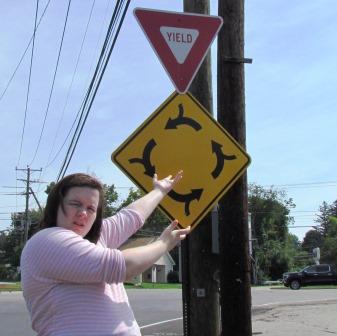
Crazy as it sounds, lots of people don’t know how to drive in a rotary.
Common sense and experience tell us to yield to traffic already in the rotary, wait for a safe opening and then proceed.
Simple, right?
It’s not a game of chicken.
Unfortunately rotaries provoke heated controversy. Some say no it’s every other driver. Um, no, that’s 4-way stops. Others seriously claim they “were taught” otherwise. Still others insist the rules used to be different.
No, the law for at least the last 50 years or so told drivers approaching rotaries to yield, and then enter only when clear. I’ll tell you how I know that below but first the actual law.
Rules of the Road
The actual law in New Hampshire includes this snippet on how to drive in a rotary:
“The driver of a vehicle approaching a yield sign shall in obedience to such shall slow down to a speed reasonable for the existing conditions and shall yield the right of way to any vehicle in the intersection or approaching on another highway so closely as to constitute an immediate hazard during the time such driver is moving across or within the intersection.”
NH RSA 265:30
This word for word quote of the law begs two questions. First the NH highway department put up yield signs at approaches to most if not all rotaries. Second, the word intersection in the law includes by definition rotaries.
“Rules of the Road” place fault on those who ignore it. “If such a driver is involved in a collision with a vehicle in the intersection after driving past a yield sign without yielding, such collision shall be deemed prima facie evidence of his failure to yield right of way.”
By the way the rules of the road also solidly establish the concept that a vehicle “passing around a rotary traffic island shall be driven only to the right of such island.” Should be obvious I know, but there it is under RSA 265:23 (III).
Rules of the Road and Fault
Massachusetts Rules of the Road provide even more clarity. The Commonwealth’s “Standards of Fault” spell out situations in which drivers face a presumption of fault. One of them:
“Collision While Merging onto a Highway, or into a Rotary. The Operator, when merging onto a highway, or into a rotary, thereafter collides with another vehicle already on the highway, or in the rotary.”
Massachusetts Standards of Fault, 211 CMR 74.04 (26).
What that means is that if there’s a collision between two cars in a rotary, the second vehicle in is presumed at-fault.
Driver’s manuals in both states explain the above concepts.
Driver’s Manuals & Rotaries
The Massachusetts Driver’s Manual explains first, traffic travels counter-clockwise and second, entering traffic must yield:
“Always yield the right-of-way to vehicles already in the rotary (unless told differently by signs or police officers) and to pedestrians.”
MA Driver’s Manual, 2020 edition, p. 100.
In probably the least enforced traffic rule on the books this manual says “use your turn signal when you are ready to exit”.
New Hampshire officials published the following in their Driver’s Manual:
“Yield to the traffic in both lanes in the roundabout. When there is an appropriate gap in traffic enter the roundabout.”
New Hampshire’s Driver’s Manual, 2020 edition p. 27.
You ask “who reads Driver’s Manuals?” Outside of new learning drivers you may well be correct. At the same time the directives are entered as evidence in depositions and at trial just to make the point clear where bad drivers cause accidents.
Difference between Rotary, Traffic Circle & Roundabout
While definitions sometimes blur depending on road configurations and design needs these traffic setups present differences.
Rotaries generally act similarly to interstate entrances in that traffic entering must yield to entering traffic. Moreover, a rotary often joins two or more major roadways allowing drivers to yield rather than come to a complete stop at a traffic signal or stop sign.
Traffic circles feature circular or sometimes elliptical islands. The fairly large center often marks off a center of town or other landmark feature in the local geography. Design features initially allowed vehicles to enter and drive around at higher speeds ranging from 30 to 50 miles per hour. Such traffic circles originally spring up in the U.S. in the early 20th Century when speeds were slower, people exercised more caution and patience, and traffic volumes were low.
Roundabouts represent an attempt to slow traffic down. Roundabouts require slower speeds so traffic engineers design physical features to alert drivers to slow down. The designs can include raised concrete circles inside an outer blacktop circular roadway. Because roundabouts require slower speeds highway officials usually place them on local roads, commercial accesses and not directly on major highways or intersections.
Rotaries: Relic of the Past?
With increased traffic volumes and the growth of bad driving habits such as distracted driving, road rage and others, is it time for highway engineers to come up with other solutions?
Massachusetts, where bad driving is notorious, sought to get rid of many rotaries. The old Drum Hill Rotary in Chelmsford, MA was replaced with a series of traffic lights. We noted the reconfiguration and replacement of the old Route 110, Route I-93 rotary in Methuen, MA in a previous blog article. And in fact the Commonwealth had a 10-year plan to get rid of the more dangerous rotaries that saw numerous accidents.
Rotaries can be confusing especially to those unfamiliar with the way roads connect or fail to do so. I grew up in Pennsylvania and spent early years visiting family in New York and the West Coast. I never saw a rotary until I moved to New England to go to college.
My college roommate told me, “See that, it’s a rotary. Slow down and yield!” That’s probably more clear than the legislative verbiage above. I never forgot it. Yes it’s been 50 years.
Author, Andrew D. Myers practices personal injury law in New Hampshire and Massachusetts. Initial free consultation available through the contact page on this website or the telephone numbers above.
Model Credit: Adrianna Bridge
Sources not cited above:
A Traffic Circle and a Roundabout Are Not the Same, Michael Wallwork, Herald Tribune.com, June 21, 2009.
Rotary or Roundabout . . . which is it?, Morgan Hughes, Boston Globe, Oct 8, 2018.
Adopted in part from “Many Motorists Don’t Know How to Drive in a Rotary” by Andrew D. Myers published in the Nutfield News/ Tri-Town News July 23, 2020.
Visits: 577





Left lane for left turn, and reversing direction,right lane right turn,and straight ahead.In the rotary,traffic nearest the rotary has the right of way.This never happens at JFK in Boston, it’s a free for all!
What if 2 cars are approaching the rotary simultaneously. The car to the right has the right of way doesn’t it?
State law and the rules of the road require that traffic entering the rotary must yield to traffic already in the rotary. If I understand the question, you’re giving the hypothetical that two vehicles approach at precisely the same second. There’s no “I am to the right I get to go first, so there.” The overriding law is that all drivers have a duty to all other vehicular traffic to operate their vehicle with due care. This means observing other traffic and acting safely in order to avoid a collision. If a car is already in the rotary it has the right of way over traffic entering the rotary.
The UK has a sensible rule – give way to the right. We drive on the left and our roundabouts go clockwise, so presumably the US equivalent would be to give way to the left.